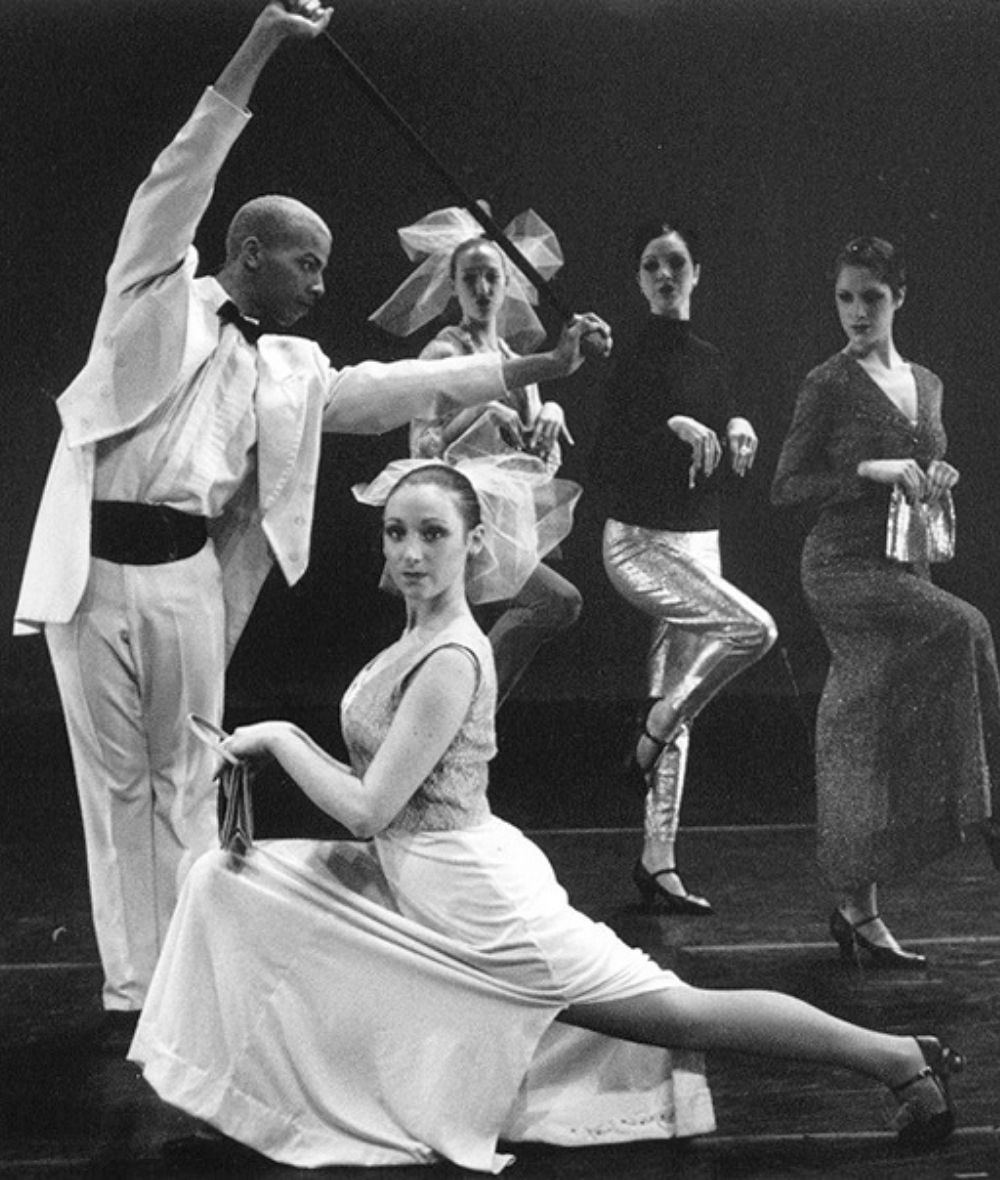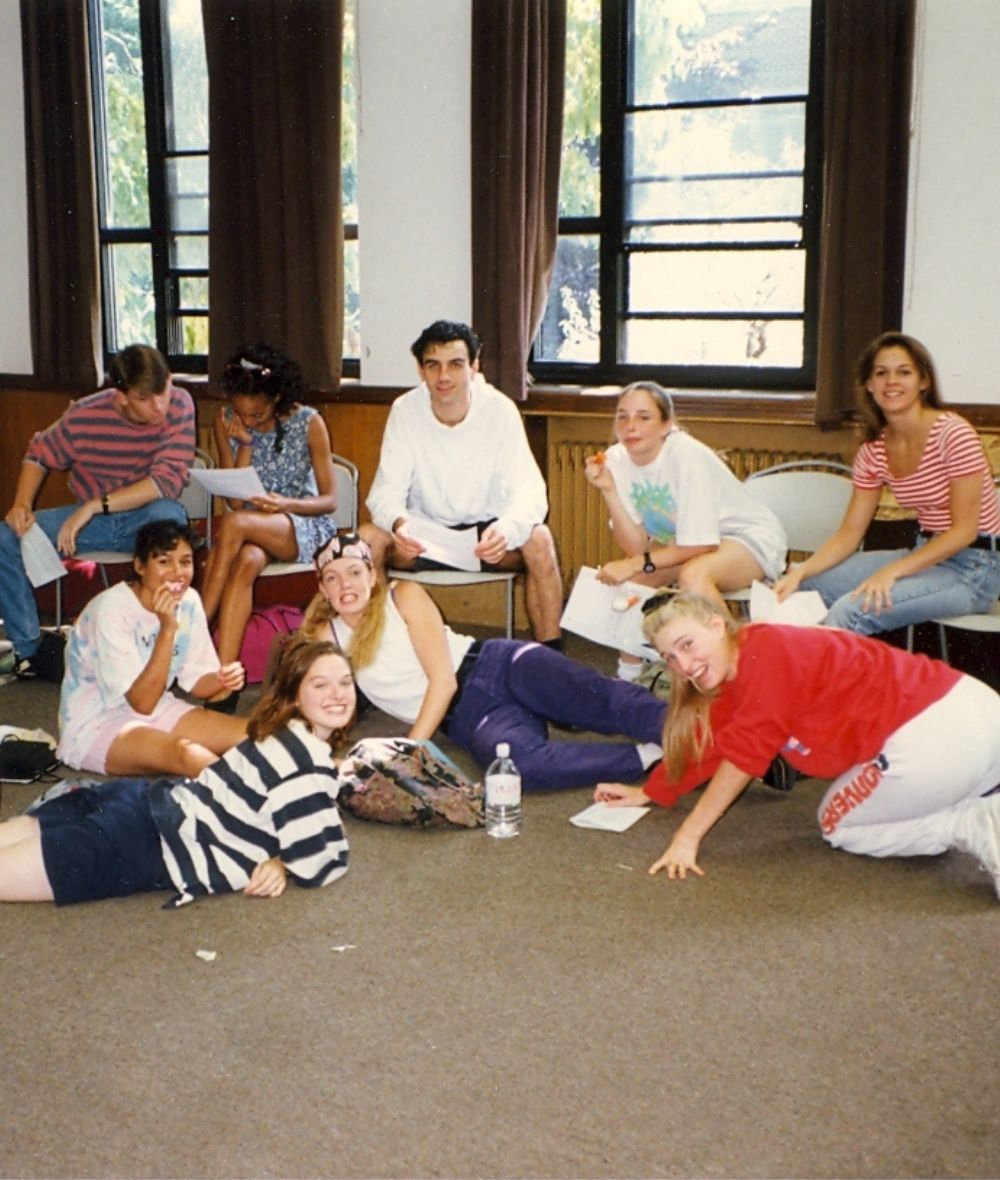From Diploma to BFA
Researched by Betty Fan and Jeanette Reyes
Written by Tanvi Vyas
1948: Polytechnic Institute
What is now called the School of Performance was founded in 1971 by Jack McAllister and Sandy Black. Originally a diploma granting institution, the change from X* Polytechnical Institute to X Polytechnical University, required dedication and years of effort across programs. When named a Polytechnic Institute in 1948, X belonged to neither the university or college systems of Ontario. While the school did grant diplomas, the general public was unclear of the specific meanings of polytechnic and institute as they related to other schools across Canada and beyond. To better operate within the national education landscape the school began granting degrees in 1971, and by 1980 a formal push for the institute to become a university began.
1971: Polytechnic Institute becomes a degree-granting institution
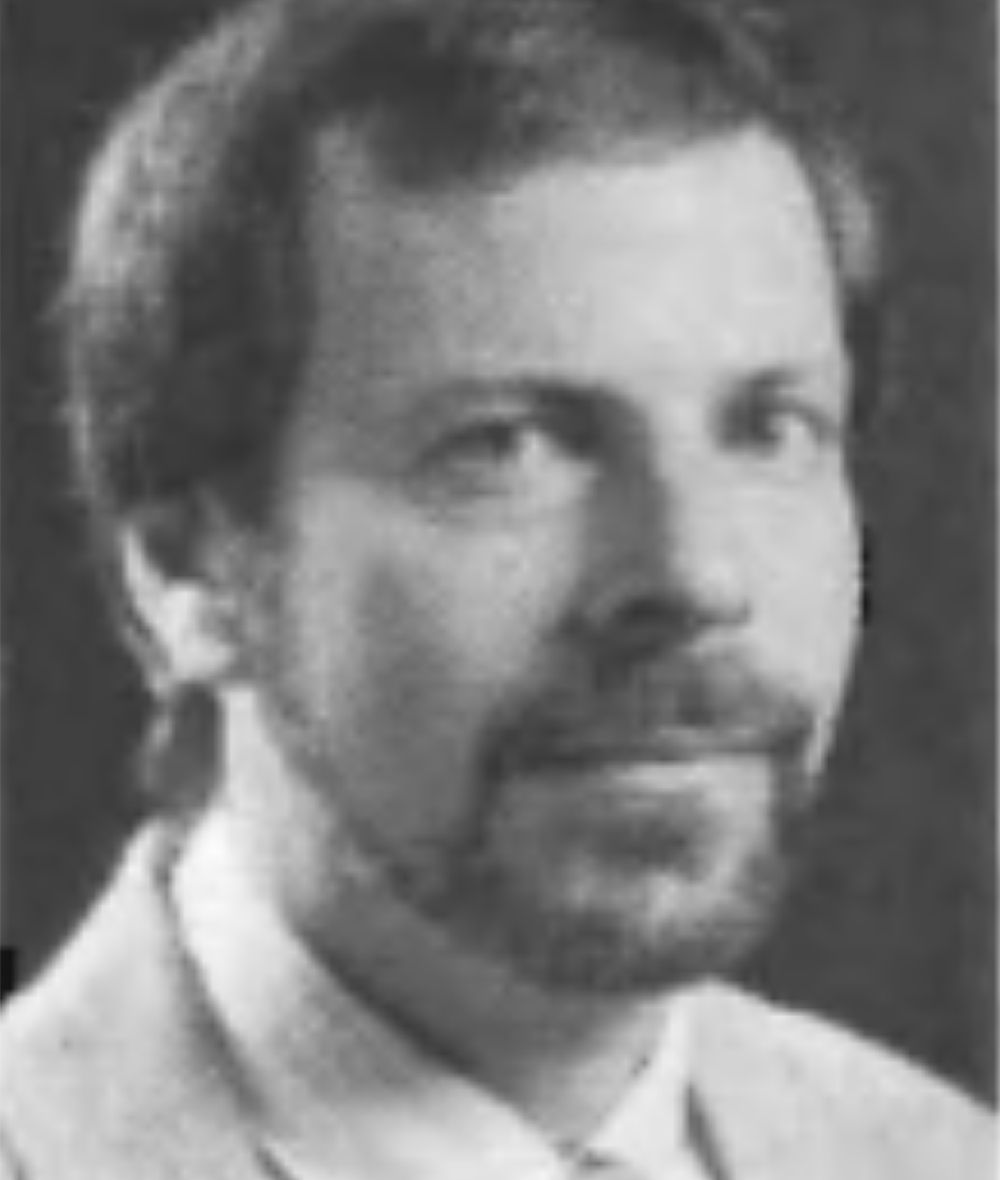
Ira Levine
Dr. Ira Levine headed the effort to allow the school to grant Bachelors of Fine Arts (BFA’s) instead of diplomas. Dr. Levine explained the motivating factors behind this endeavor and the importance of successes, saying “diploma programs were not the place to be ''. Due to the efforts of the school at large and individual Faculties, many programs had already shifted to granting Bachelor's Degrees. This put RTS in a tight spot. The school administered three diploma programs in acting, dance, and production and had an uphill climb to advocate for performing arts position in academia., As Dr. Levine explained, “questions were raised about the long term viability and contribution of the theatre school [...]to protect the future of theatre school programs, [we] had better change from diploma programs to degree programs”.
1980-1993: Efforts to obtain university status
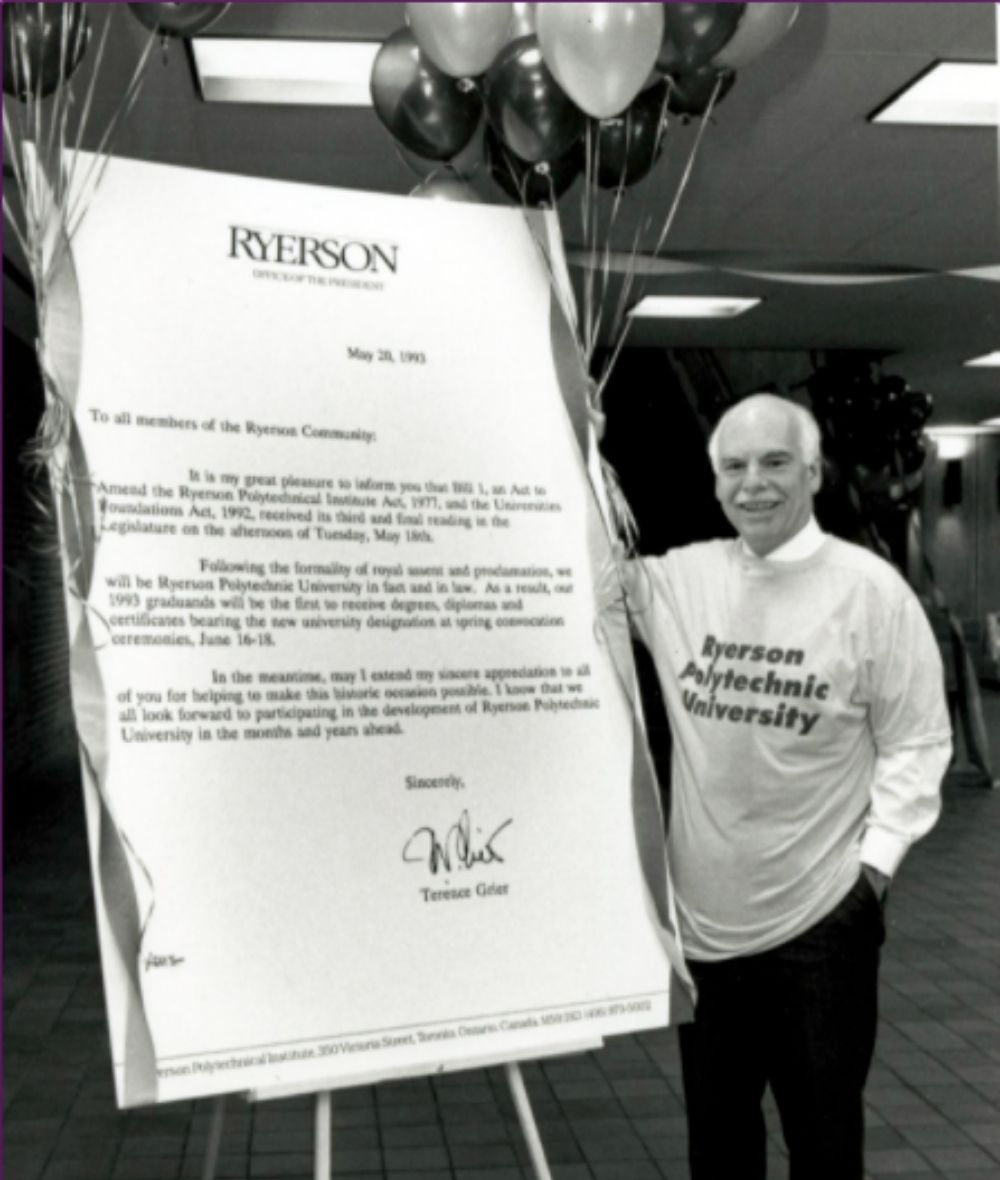
X President Terry Greer stands beside a notice congratulating the school on receiving University status, 1993.
This process was far from simple. When the official process began in the 1980’s, the institue began lobbying the government, and a Research Mandate Committee was formed in 1990. As Chair of RTS, Dr. Levine took part in this committee. The committee made the case to the government that there was enough research activity to justify transitioning into a university. In 1993 they were successful, and X Polytechnic Institute became X Polytechnic University. A few years later, the name was changed once again to the one we are currently familiar with; X University.
The name change marked the beginning of the secondary process, shifting programs from diplomas to degrees, and removing programs that could not transition.
The university established a system to assist programs in this transition, and Dr. Levine - who was now the Dean of Applied Arts, which is currently known as The Creative School - sat down with colleagues and faculty at RTS to inform them of steps, documentation, and external validation that needed to be fulfilled in order for RTS to become a degree granting institution. Working on the proposals were Sandy Black (production), Nadia Potts (dance), Dr. Iris MacGregor Bannerman (acting), and of course Dr. Levine, who approved all proposals.
The university insisted that all programs fulfill a societal need in order to remain a part of the institution. The case to prove the necessity of each of the three RTS individual disciplines was in no way straightforward or easy, but thankfully, the group had a few aces up their sleeves. First was Jimmy Fuller, a longtime president of IATSE Local 58 who was a supporter of RTS. This relationship facilitated a number of graduates joining the IATSE Union every year. Sandy Black and Dr. Levine worked with Fuller to prove that IATSE needed technicians with the skills and level training that RTS provided. Acting and Dance were harder to fight for - it was a challenge to prove there was a need for performers to have a degree in order to build a career. This said, RTS was the only program in Canada that taught the dance syllabus from the Royal Academy of Dance. Nadia Potts and Dr. Bannerman were able to point out that Canada was “importing Royal Academy trained teachers” (Levine) through immigration records. Extending the program allows dancers to graduate with the qualifications to become teachers themselves, further sharing the RAD curriculum domestically. Overall the Theatre School was the only program that provided such a high level of training and was able to boast a high number of well placed, successful alumni.
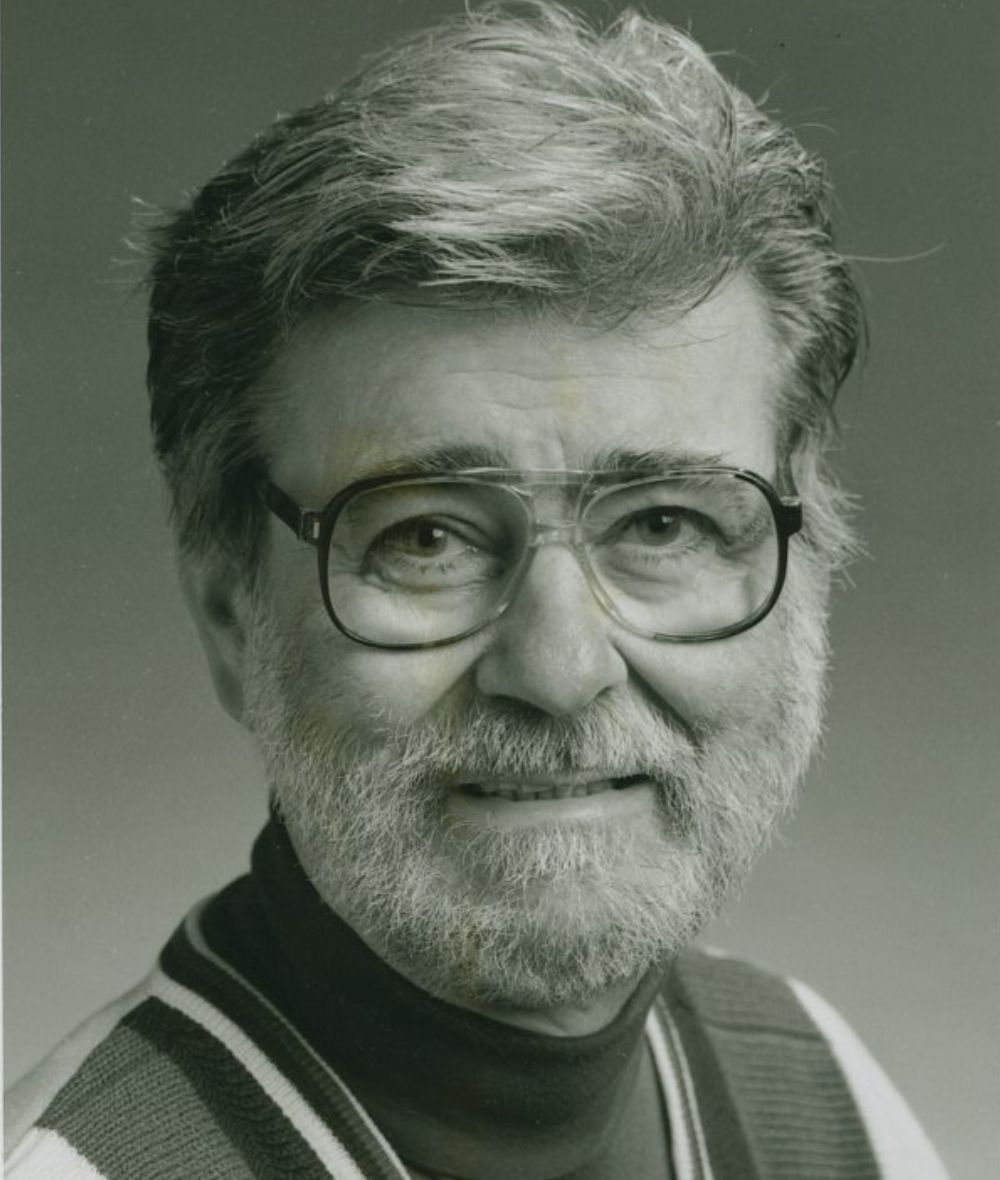
Sandy Black
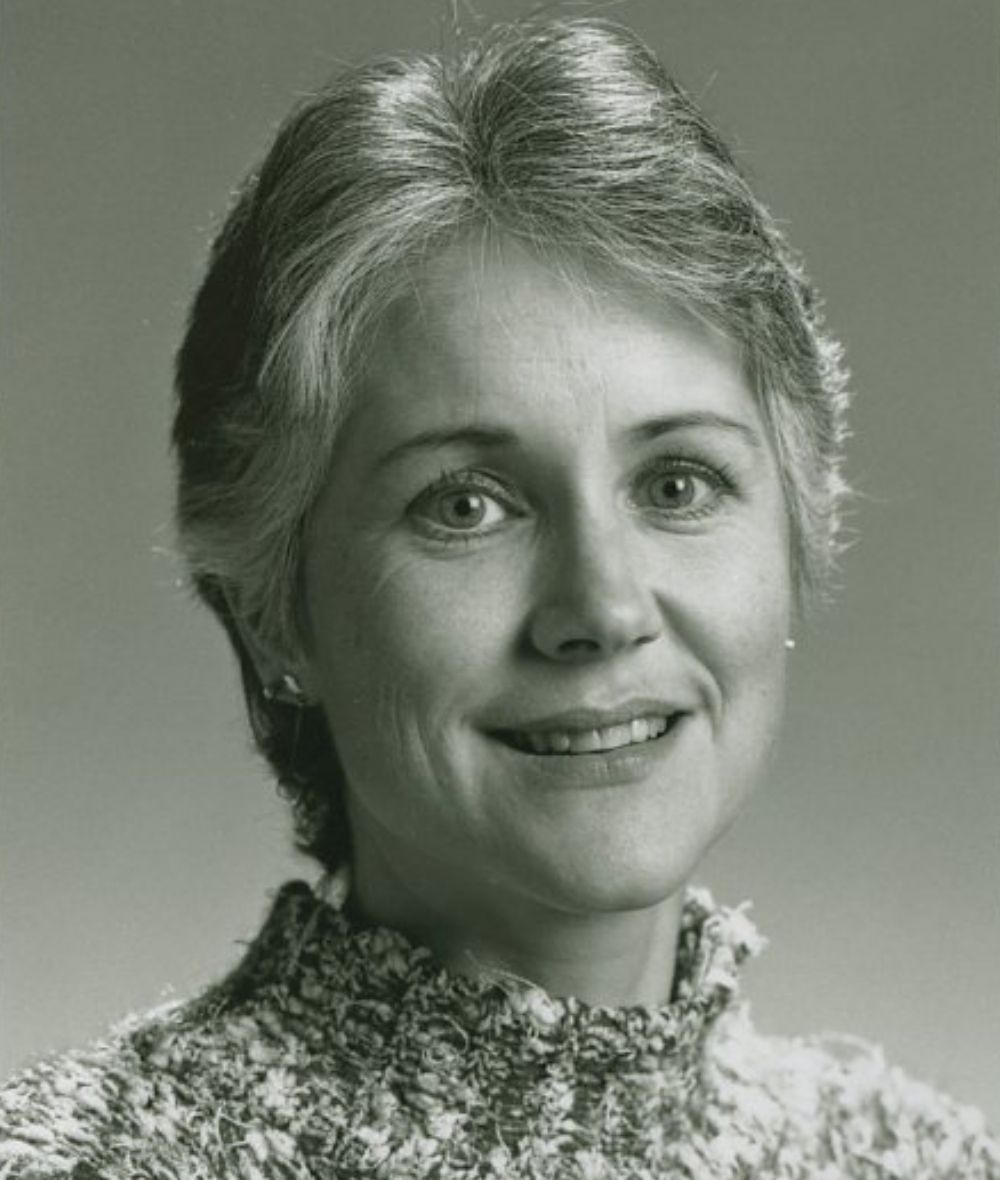
Nadia Potts
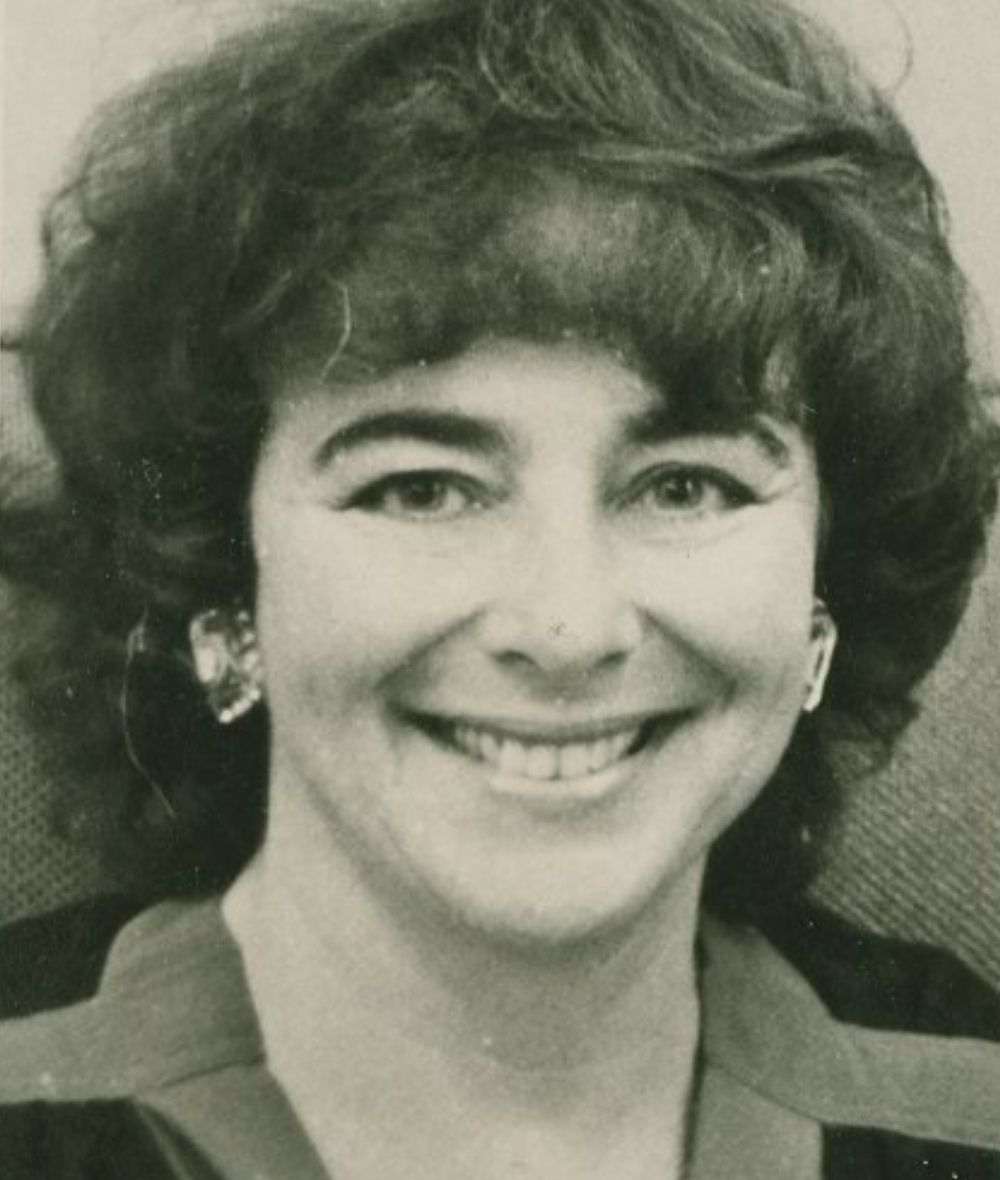
Dr. Iris MacGregor Bannerman
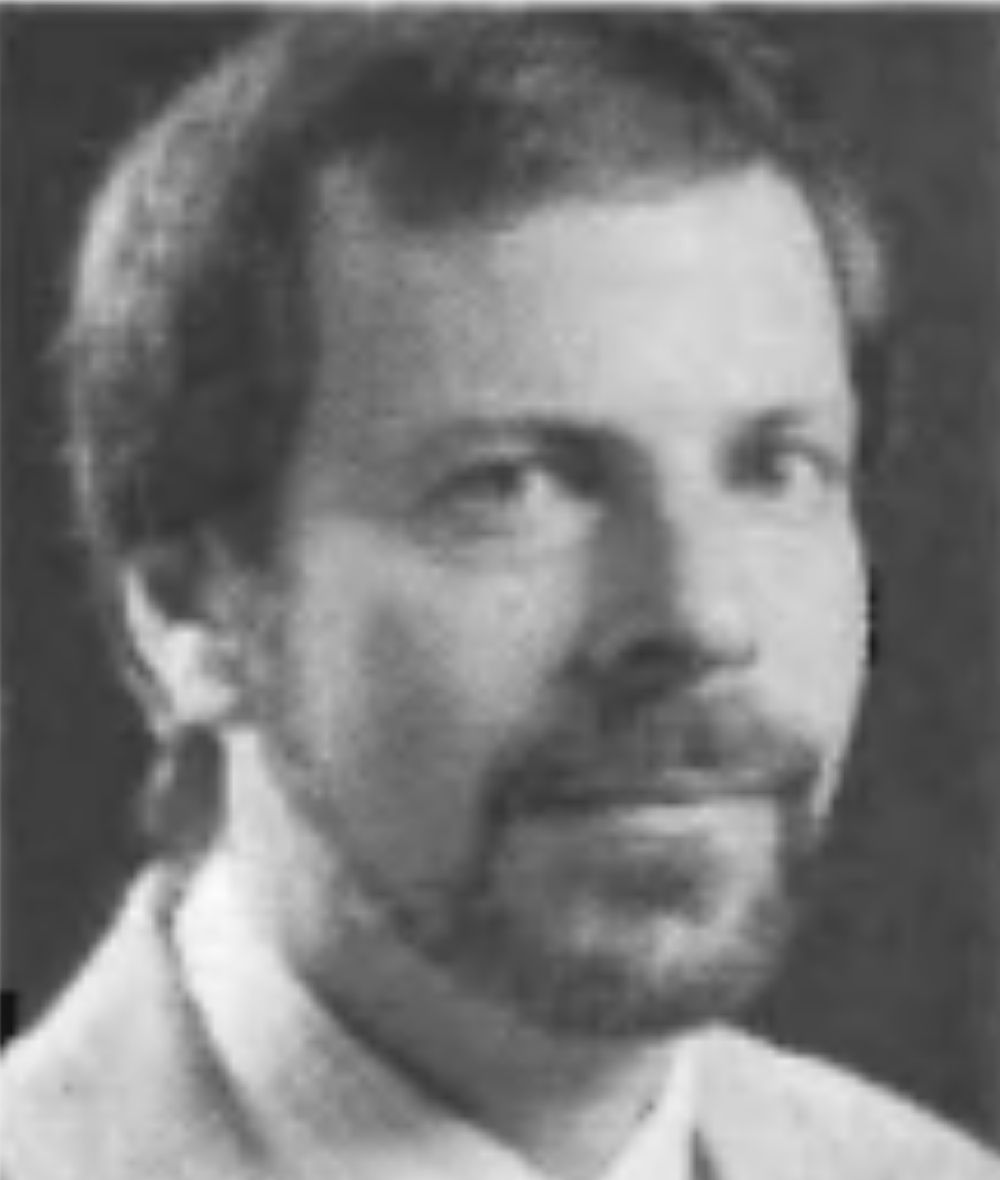
Dr. Ira Levine
1994 - 1997: Province approves degree granting program for Performance - transition period begins
It was decided that in order to ensure all three programs stay up and running, acting would be grouped together with dance to create the BFA in Performance Acting/Dance which remains the degrees title to this day. In the later part of the 1990s, both proposals were approved such that in the eyes of the Province of Ontario, the School of Performance only has two programs: Performance Production and Performance Acting/Dance. Dr. Levine wanted to emphasize that if this transition was not approved the School would not exist today.
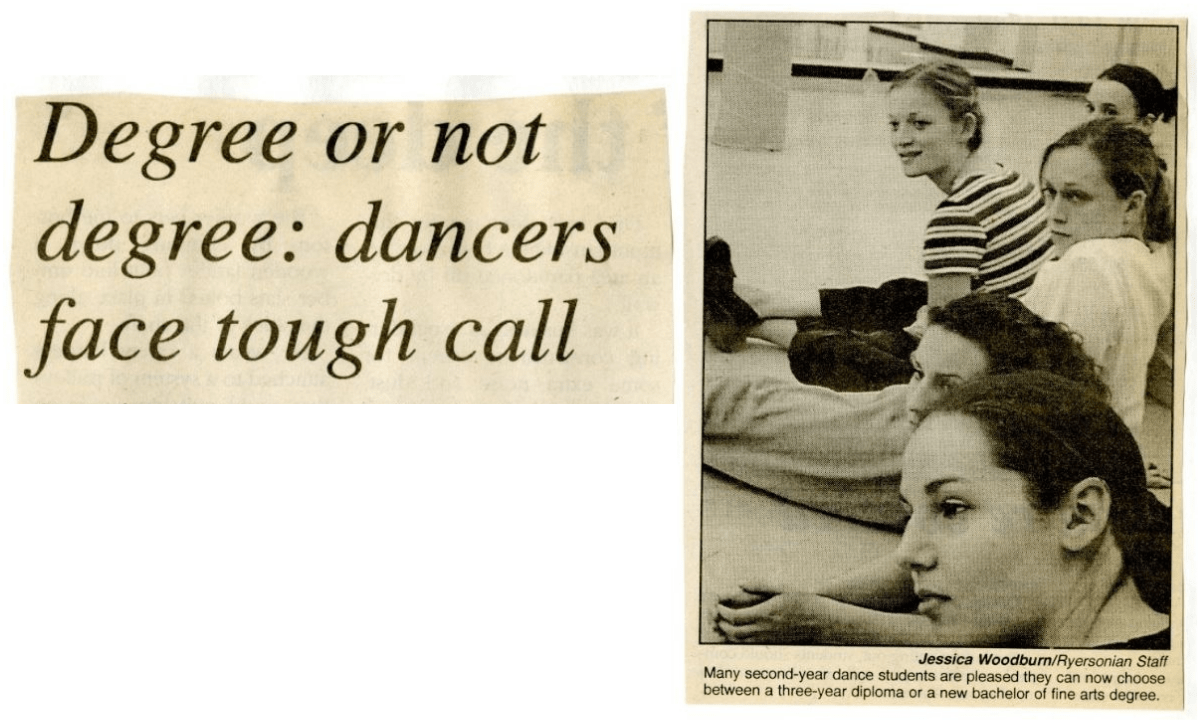
Article from On The Record, September 22, 1999
Unfortunately, as is common during times with great change, many alumni, students and faculty were not thrilled at this development. Some alumni thought it would devalue their diploma and faculty had to cut back on hours in the classroom in order to keep up with new research demands. The school did offer solutions, allowing graduates to return and earn their degrees, which many did. In general graduates now have more options with a degree and the shift allowed the university to create graduate programs, including the new MFA in Scriptwriting & Story Design, which Performance contributes to.
This was in 1995, when The Creative School was still the Faculty of Applied Arts. There were almost no faculty members within RTS who had Doctorate or Masters Degrees, and many were not participating in academic research either. As Dean, Dr. Levine did not want the faculty to fall behind, but the only way to initiate graduate programs was if the faculty could supervise and teach students at a graduate level. X therefore developed a relationship with York University to establish its first graduate program. The Masters in Communication and Culture administered jointly by York and X operates to this day. The number of programs continued to grow over the years and so did the reputation of the school.
While this was an internal process, the School did need to be aware of the opinions of the wider theatre community and the arts education community. Dr. Levine explained how it was a gradual process for the industry to conclude the new alumni were just as capable in practical skills as the old and the program became even more competitive with other University and College programs. A few College programs even followed in RTS’s steps, moving away from diplomas to offer degrees.
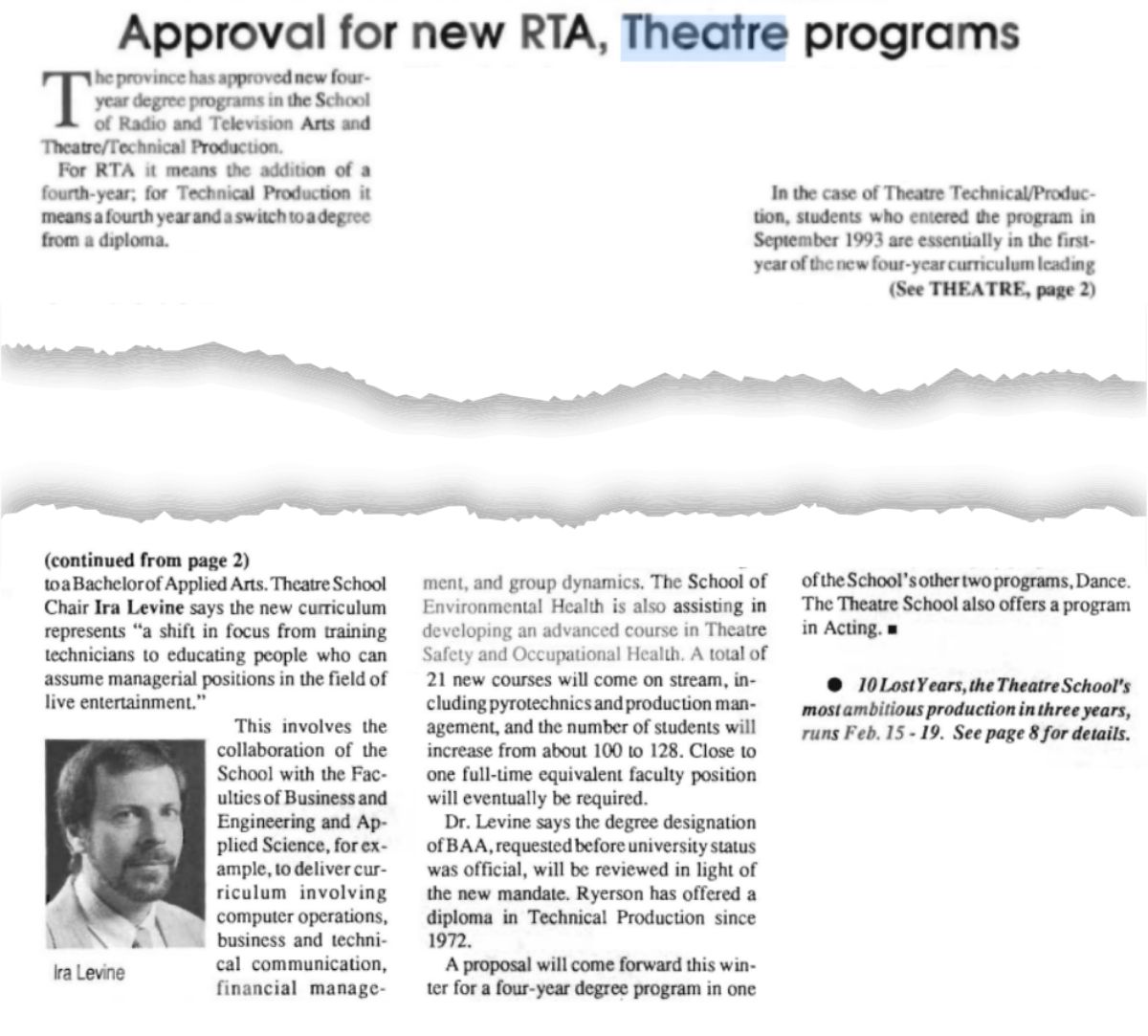
From FORUM, February 4, 1994
This change prompted a ripple of adjustments throughout the school: 21 new courses were added to the stream, including pyrotechnics and production management, the number of students increased from about 100 to 128 per year, and a new faculty position was added. In Dr. Levine’s words, “inevitably, as you move from a diploma to a degree program, academic standards go up” and this is evidenced by the addition of history and health & safety courses. Both require students to demonstrate a high level of academic skills, but also provide students with information vital to their careers. For example, the implementation of health and safety courses emphasized the need for better safety precautions across the performance industry. Alumni like Janet Sellery have gone on to revolutionize health and safety in the performance industry, and she returns to teach the course as well. Furthermore, a degree legitimized the program in the eyes of many parents, especially because it provides more flexibility after graduation, meaning a greater diversity of students are receiving the support of their families’ to attend. An interesting observation Dr. Levine noted is that with the exception of dance, in moving from diploma to degree, the students got younger. As a diploma program acting and production would attract more mature students with some work experience, compared to now when each year the incoming class is made up increasingly of high school graduates. He noted how the transition "changed the perception of applicants” and “[ours] continues to be the most transferred into university in Ontario.”

Article from On The Record, November 15, 2000
Overall the entire process lasted from 1971 to 1997 with a variety of challenges along the way. As the years go by and the School of Performance continues to grow and change, the benefits of a degree program continue to accumulate. Graduates are able to go on and continue their education in higher studies, some even use the degree to transfer into an entirely different career path, including law and medical fields. Through their academic achievements, students and alumni have also earned the reputation of being thinking artists - intelligent people who are innovating their industry and challenging standards. The approval of the degree program took decades, the transition took years, and the School of Performance only continues to exist because of the ceaseless work of the faculty and staff involved in the process. The school adapted to a changing educational landscape to ensure that theatre artists are acknowledged, taken seriously, and receive the training and education they need to succeed, something we should all appreciate.
A special thank you to Dr. Ira Levine for sharing his memories of this time.
*The Standing Strong (Mash Koh Wee Kah Pooh Win) Task Force has submitted its final report with recommendation to develop principles to guide commemoration at the university and to respond to the history and legacy of the university's namesake. Included in the list of 22 recommendations agreed to by the university's administration, is the call to change the university's name.
